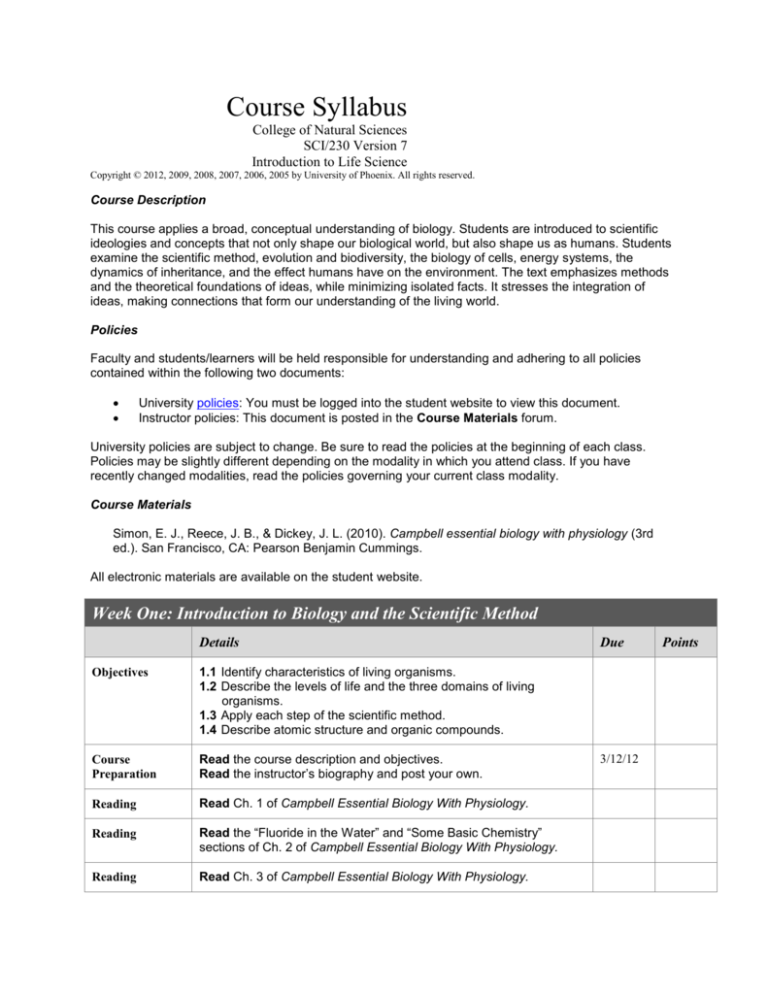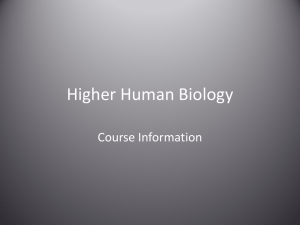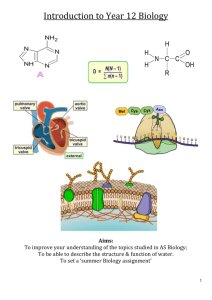
Course Syllabus
College of Natural Sciences
SCI/230 Version 7
Introduction to Life Science
Copyright © 2012, 2009, 2008, 2007, 2006, 2005 by University of Phoenix. All rights reserved.
Course Description
This course applies a broad, conceptual understanding of biology. Students are introduced to scientific
ideologies and concepts that not only shape our biological world, but also shape us as humans. Students
examine the scientific method, evolution and biodiversity, the biology of cells, energy systems, the
dynamics of inheritance, and the effect humans have on the environment. The text emphasizes methods
and the theoretical foundations of ideas, while minimizing isolated facts. It stresses the integration of
ideas, making connections that form our understanding of the living world.
Policies
Faculty and students/learners will be held responsible for understanding and adhering to all policies
contained within the following two documents:
University policies: You must be logged into the student website to view this document.
Instructor policies: This document is posted in the Course Materials forum.
University policies are subject to change. Be sure to read the policies at the beginning of each class.
Policies may be slightly different depending on the modality in which you attend class. If you have
recently changed modalities, read the policies governing your current class modality.
Course Materials
Simon, E. J., Reece, J. B., & Dickey, J. L. (2010). Campbell essential biology with physiology (3rd
ed.). San Francisco, CA: Pearson Benjamin Cummings.
All electronic materials are available on the student website.
Week One: Introduction to Biology and the Scientific Method
Details
Objectives
1.1 Identify characteristics of living organisms.
1.2 Describe the levels of life and the three domains of living
organisms.
1.3 Apply each step of the scientific method.
1.4 Describe atomic structure and organic compounds.
Course
Preparation
Read the course description and objectives.
Read the instructor’s biography and post your own.
Reading
Read Ch. 1 of Campbell Essential Biology With Physiology.
Reading
Read the “Fluoride in the Water” and “Some Basic Chemistry”
sections of Ch. 2 of Campbell Essential Biology With Physiology.
Reading
Read Ch. 3 of Campbell Essential Biology With Physiology.
Due
3/12/12
Points
Reading
Read the University of Phoenix Material: Discussing Controversial
Topics located on the student website.
Nongraded
Activities and
Preparation
Process of
Science
Listen to the Process of Science MP3 recording located on the
student website.
Individual
Levels of Life
Complete the Levels of Life Worksheet located on the student
website.
3/16/12
100
Individual
The Scientific
Method
Complete the Scientific Method activity on the student website.
Write a 350-word paper on the scientific method. Include the
following:
3/18/12
90
Due
Points
Describe how you applied the steps of the scientific method
in the activity.
Describe a real-life problem where you have or could have
used the steps of the scientific method to solve the problem.
Include the steps involved in solving the problem.
Format your paper consistent with APA guidelines.
Week Two: Cells
Details
Objectives
2.1
2.2
2.3
2.4
Compare the structures of prokaryotic and eukaryotic cells.
Differentiate between plant and animal cells.
Describe photosynthesis and cellular respiration.
Describe mitosis and meiosis.
Reading
Read Ch. 4 of Campbell Essential Biology With Physiology.
Reading
Read Ch. 6 of Campbell Essential Biology With Physiology.
Reading
Read Ch. 7 of Campbell Essential Biology With Physiology.
Reading
Read Ch. 8 of Campbell Essential Biology With Physiology.
Participation
Participate in class discussion.
10
Discussion
Questions
Respond to weekly discussion questions.
10
Nongraded
Activities and
Preparation
Mitosis and
Meiosis
Listen to the following MP3 recordings located on the student
website:
“Mitosis”
“Meiosis”
“Comparing Mitosis and Meiosis”
Nongraded
Activities and
Preparation
Animal and Plant
Cells
Watch the following videos located on the student website:
Nongraded
Activities and
Preparation
Photosynthesis
and Cellular
Respiration
Watch the following videos located on the student website:
Nongraded
Activities and
Preparation
Cellular
Reproduction
Watch the following videos located on the student website:
Individual
Cells
Complete the Prokaryotic and Eukaryotic Cells activity on the
student website.
Complete the Prokaryotic and Eukaryotic Cells Worksheet.
“Tour of a Plant Cell”
“Tour of an Animal Cell”
“Overview of Cellular Respiration”
“Cellular Respiration”
“Overview of Photosynthesis”
“Photosynthesis”
“Mitosis & Cytokinesis Animation”
“Meiosis Animation”
3/25/12
30
Due
Points
Week Three: Cells, continued
Details
Objectives
3.1
3.2
3.3
3.4
Compare the structures of prokaryotic and eukaryotic cells.
Differentiate between plant and animal cells.
Describe photosynthesis and cellular respiration.
Describe mitosis and meiosis.
Individual
Cell Energy
Complete the Cell Energy Worksheet.
3/30/12
90
Individual
Cell Reproduction
Create a multimedia presentation wherein you answer the following
questions:
4/1/12
100
What types of cells and organisms undergo mitosis and
meiosis?
When do organisms use each process?
Review the illustration of each process in Figure 8.15 in Ch.
8 of Campbell Essential Biology With Physiology. In which
phases do the important differences occur? How do these
differences affect the end results?
What would happen to an organism if either process
stopped?
Examples of multimedia presentation tools include the following:
Voki™ speaking avatars
Microsoft® PowerPoint® presentations of at least 5 slides
with detailed speaker notes
Prezi™ presentations
VoiceThread™ collaborative multimedia slide shows
Digital StorytellerSM movies
Glogster™ interactive posters
Websites
Week Four: DNA, Chromosomes, and Genetics
Details
Due
Points
Objectives
4.1
4.2
4.3
4.4
Describe the principles of genetics.
Apply the principles of Mendelian genetics.
Explain the role of chromosomes in inheritance.
Describe the structure and function of DNA.
Reading
Read Ch. 9 of Campbell Essential Biology With Physiology.
Reading
Read Ch. 10 of Campbell Essential Biology With Physiology.
Participation
Participate in class discussion.
10
Discussion
Questions
Respond to weekly discussion questions.
10
Nongraded
Activities and
Preparation
Chromosomal
Basis of
Inheritance
Listen to the “Chromosomal Basis of Inheritance” MP3 recording
located on the student website.
Nongraded
Activities and
Preparation
DNA to RNA to
Protein
Listen to the “DNA to RNA to Protein” MP3 recording located on the
student website.
Nongraded
Activities and
Preparation
Protein Synthesis
Watch the following videos located on the student website:
Nongraded
Activities and
Complete the Punnett Square activity located on the student
website.
“Overview of Protein Synthesis”
“Protein Synthesis”
Preparation
Punnett Squares
Week Five: DNA, Chromosomes, and Genetics, continued
Details
Due
Points
Objectives
5.1
5.2
5.3
5.4
Describe the principles of genetics.
Apply the principles of Mendelian genetics.
Explain the role of chromosomes in inheritance.
Describe the structure and function of DNA.
Individual
DNA Assignment
Complete the DNA Worksheet located on the student website.
4/13/12
70
Individual
Genetics
Assignment
Complete the Genetics Worksheet located on the student website.
4/15/12
100
Due
Points
Week Six: Evolution and Physiology
Details
Objectives
6.1 Explain the role of natural selection in evolution.
6.2 Describe the evidence in support of evolution by natural
selection.
6.3 Explain how new species evolve.
6.4 Explain how organisms evolved physiologically in response to
their environment.
Reading
Read the following sections in Ch. 13 of Campbell Essential Biology
With Physiology:
Reading
Read the following sections in Ch. 13 of Campbell Essential Biology
With Physiology:
Reading
“Biology and Society: Evolution in Action”
“Charles Darwin and The Origin of Species”
“Evidence of Evolution”
“Natural Selection”
“Mechanisms of Evolution”
Read the following sections in Ch. 14 of Campbell Essential Biology
With Physiology.
“Biology and Society: Mass Extinctions”
“Macroevolution and the Diversity of Life”
“The Origin of Species”
“The Evolution of Biological Novelty”
Reading
Read Ch. 17 of Campbell Essential Biology With Physiology.
Reading
Read Ch. 21 of Campbell Essential Biology With Physiology.
Participation
Participate in class discussion.
10
Discussion
Questions
Respond to weekly discussion questions.
10
Nongraded
Activities and
Preparation
Natural Selection
Listen to the “Natural Selection” MP3 recording located on the
student website.
Nongraded
Activities and
Preparation
Speciation
Listen to the “Speciation” MP3 recording located on the student
website.
Nongraded
Activities and
Preparation
Animal Structure
Listen to the “Animal Structure” MP3 recording located on the
student website.
Nongraded
Activities and
Preparation
The Mechanisms
of Evolution –
Natural Selection
Camouflage
Watch the “Mechanisms of Evolution – Natural Selection:
Camouflage” video located on the student website.
Week Seven: Evolution and Physiology, continued
Details
Objectives
7.1 Explain the role of natural selection in evolution.
7.2 Describe the evidence in support of evolution by natural
selection.
7.3 Explain how new species evolve.
7.4 Explain how organisms evolved physiologically in response to
their environment.
Individual
Physiology
Assignment
Locate a diagram of the internal anatomy of an organism with the
main organs and structures labeled.
Write a 350- to 700-word paper explaining how the organism in the
diagram has evolved physiologically to become suited to its
environment.
Reference the diagram in your paper.
Due
Points
4/27/12
70
Format your paper consistent with APA guidelines.
Individual
Evolution
Assignment
Resource: “The Origin of Species” section in Ch. 14 of Campbell
Essential Biology With Physiology
Choose a species to research.
Create a 7- to 10-slide Microsoft® PowerPoint® presentation about
your chosen species.
Include the following in your presentation:
4/29/12
100
Due
Points
How may your species have evolved?
Describe the mechanism of speciation, in general, and apply
the mechanism to the species you researched.
Include evidence that supports your speciation hypothesis.
What role does natural selection play with this species?
What role does it play with evolution in general? Does that apply
to this species?
Include detailed speaker notes.
Week Eight: Ecology and Biodiversity
Details
Objectives
8.1 Describe the basic structure and interactions of a healthy
ecosystem.
8.2 Differentiate between logistic and exponential growth.
8.3 Recognize the importance of biodiversity.
8.4 Explain a threat to biodiversity.
Reading
Read Ch. 18 of Campbell Essential Biology With Physiology.
Reading
Read Ch. 19 of Campbell Essential Biology With Physiology.
Reading
Read the following sections in Ch. 20 of Campbell Essential Biology
With Physiology:
“Biology and Society: The Loss of Biodiversity”
“The Loss of Biodiversity”
“Trophic Structure”
“Ecosystem Ecology”
Participation
Participate in class discussion.
10
Discussion
Questions
Respond to weekly discussion questions.
10
Nongraded
Activities and
Preparation
Ecological
Hierarchy
Listen to the “Ecological Hierarchy” MP3 recording located on the
student website.
Nongraded
Activities and
Preparation
Global Warming
Listen to the “Global Warming” MP3 recording located on the student
website.
Week Nine: Ecology and Biodiversity, continued
Details
Objectives
9.1 Describe the basic structure and interactions of a healthy
ecosystem.
9.2 Differentiate between logistic and exponential growth.
9.3 Recognize the importance of biodiversity.
9.4 Explain a threat to biodiversity.
Individual
Human
Population
Growth
Write a total of 150- to 300-words in response to the following:
Individual
Food Web
Diagram
Create a diagram in which you illustrate the energy flow among
organisms of a food chain in a particular ecosystem.
Select an ecosystem, such as a temperate forest, desert biome, or
the Everglades.
Determine the interdependency of life in your ecosystem by
examining its organisms.
Include the following:
Due
Points
5/11/12
70
5/13/12
100
Explain the two types of population growth.
Analyze the type of growth exhibited by the human
population and its effect on the environment.
List the organisms that can be found in your ecosystem.
What is the benefit of this biodiversity?
Label major organisms that live in your selected ecosystem:
P for producers, C for consumers, and D for decomposers.
Write a summary of your food chain that:
Describes the major categories of organisms: producers,
consumers, and decomposers.
Describes the interactions between organisms in your
ecosystem.
Evaluates potential hazards caused by humans that might
affect your ecosystem’s stability, such as environmental pollution.
What effect does this hazard have on the biodiversity in your
ecosystem?
Lists the abiotic factors present in your ecosystem.
Describes the food chains associated with your ecosystem.
Address the following items:
o
o
o
o
Name of the plant or animal
What it eats
What eats it
How it has adapted to the ecosystem
Optional Discussion Questions
Week Two Discussion Questions
Why is it important to differentiate between eukaryotic and prokaryotic cells? What do you think is
the biggest difference between the two?
For the cell process assigned to you by your instructor (mitosis, meiosis, photosynthesis or cell
respiration), answer the following:
o What is the purpose of the cell process?
o What would happen to the cell and the organism if the process stopped occurring?
o Can you think of another way the cell could achieve this process?
Week Four Discussion Questions
Select two of Mendel’s four hypotheses that are described in Ch. 9 of Campbell Essential Biology
With Physiology. How could you rewrite these in your own words? Find an example that illustrates the
hypotheses.
Choose a trait or disorder controlled by one gene. Briefly describe the trait and identify whether it
is inherited as a dominant, recessive, or sex-linked trait. What would a pedigree of this trait look like?
Why is DNA sequencing important?
Week Six Discussion Questions
Review the “Natural Selection” section in Ch. 13 of Campbell Essential Biology With Physiology.
Organisms have evolved physiologically and anatomically to adapt to their environment. Select one
species from the text or another source. How have their traits evolved by natural selection to
maximize their ability to maintain homeostasis and equilibrium?
What are two examples of evidence that support the theory of evolution by natural selection?
One example should relate to the anatomy or physiology of animals. Locate a website that discusses
the evolution of a new species. Do you agree this is a new species, or is it diversity within the same
species? Explain your answer.
Week Eight Discussion Questions
Describe your local ecosystem or an ecosystem that is important to you, including its hierarchy of
interactions and its biodiversity. How is the ecosystem dependent on the biodiversity? Explain one
threat to that biodiversity.
Are all threats to biodiversity caused by humans?
Copyright
University of Phoenix® is a registered trademark of Apollo Group, Inc. in the United States and/or other countries.
Microsoft®, Windows®, and Windows NT® are registered trademarks of Microsoft Corporation in the United States and/or other countries. All
other company and product names are trademarks or registered trademarks of their respective companies. Use of these marks is not intended to
imply endorsement, sponsorship, or affiliation.
Edited in accordance with University of Phoenix® editorial standards and practices.









